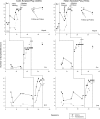Using video modeling to teach reciprocal pretend play to children with autism
- PMID: 19721729
- PMCID: PMC2649844
- DOI: 10.1901/jaba.2009.42-43
Using video modeling to teach reciprocal pretend play to children with autism
Abstract
The purpose of the present study was to use video modeling to teach children with autism to engage in reciprocal pretend play with typically developing peers. Scripted play scenarios involving various verbalizations and play actions with adults as models were videotaped. Two children with autism were each paired with a typically developing child, and a multiple-probe design across three play sets was used to evaluate the effects of the video modeling procedure. Results indicated that both children with autism and the typically developing peers acquired the sequences of scripted verbalizations and play actions quickly and maintained this performance during follow-up probes. In addition, probes indicated an increase in the mean number of unscripted verbalizations as well as reciprocal verbal interactions and cooperative play. These findings are discussed as they relate to the development of reciprocal pretend-play repertoires in young children with autism.
Keywords: autism; pretend play; video modeling.
Figures
Similar articles
-
Effects of Joint Video Modeling on Unscripted Play Behavior of Children with Autism Spectrum Disorder.J Autism Dev Disord. 2019 Jan;49(1):236-247. doi: 10.1007/s10803-018-3719-2. J Autism Dev Disord. 2019. PMID: 30136112
-
Using video modeling with substitutable loops to teach varied play to children with autism.J Appl Behav Anal. 2013 Fall;46(3):662-8. doi: 10.1002/jaba.68. J Appl Behav Anal. 2013. PMID: 24114229
-
Using video modeling to teach complex social sequences to children with autism.J Autism Dev Disord. 2007 Apr;37(4):678-93. doi: 10.1007/s10803-006-0195-x. J Autism Dev Disord. 2007. PMID: 16897375
-
A review of research into pretend play in autism.Autism. 2003 Dec;7(4):379-90. doi: 10.1177/1362361303007004004. Autism. 2003. PMID: 14678677 Review.
-
Language play in children with autism spectrum disorders: implications for practice.Semin Speech Lang. 2006 Feb;27(1):21-31. doi: 10.1055/s-2006-932436. Semin Speech Lang. 2006. PMID: 16440242 Review.
Cited by
-
Can I Learn to Play? Randomized Control Trial to Assess Effectiveness of a Peer-Mediated Intervention to Improve Play in Children with Autism Spectrum Disorder.J Autism Dev Disord. 2021 Jun;51(6):1823-1838. doi: 10.1007/s10803-020-04671-5. J Autism Dev Disord. 2021. PMID: 32870416 Clinical Trial.
-
Use of an iPad play story to increase play dialogue of preschoolers with Autism Spectrum Disorders.J Autism Dev Disord. 2013 Sep;43(9):2174-89. doi: 10.1007/s10803-013-1770-6. J Autism Dev Disord. 2013. PMID: 23371509
-
Play, Playfulness, and Self-Efficacy: Parental Experiences with Children on the Autism Spectrum.Occup Ther Int. 2018 Oct 1;2018:4636780. doi: 10.1155/2018/4636780. eCollection 2018. Occup Ther Int. 2018. PMID: 30364095 Free PMC article.
-
Increasing the athletic group play of children with autism.J Autism Dev Disord. 2014 Jan;44(1):41-54. doi: 10.1007/s10803-013-1850-7. J Autism Dev Disord. 2014. PMID: 23700189
-
Effects of Joint Video Modeling on Unscripted Play Behavior of Children with Autism Spectrum Disorder.J Autism Dev Disord. 2019 Jan;49(1):236-247. doi: 10.1007/s10803-018-3719-2. J Autism Dev Disord. 2019. PMID: 30136112
References
-
- Baer D.M, Wolf M.M. The entry into natural communities of reinforcement. In: Ulrich R, Stachnik T, Mabry J, editors. Control of human behavior (Vol. 2, pp. 319–324) Glenview, IL: Scott Foresman; 1970.
-
- Charlop-Christy M.H, Le L, Daneshvar S. Using video modeling to teach perspective taking to children with autism. Journal of Positive Behavior Interventions. 2003;5:12–21.
-
- Charlop-Christy M.H, Le L, Freeman K.A. A comparison of video modeling with in vivo modeling for teaching children with autism. Journal of Autism and Developmental Disorders. 2000;30:537–552. - PubMed
-
- D'Ateno P, Mangiapanello K, Taylor B. Using video modeling to teach complex play sequences to a preschooler with autism. Journal of Positive Behavior Interventions. 2003;5:5–11.
Publication types
MeSH terms
LinkOut - more resources
Full Text Sources



